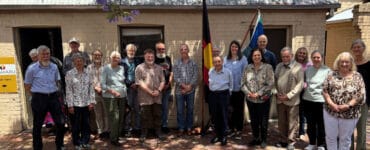by Libby Byrne
The gift of art helps us see more clearly what is really there in our human experience. With this in mind, is there a relationship between the way we see art and the way we imagine religious communities might be inclusive for people with disabilities?
In the process of making and seeing a work of art, artist and viewer are both invited to see and be seen. The aesthetic experience of seeing art can nourish our sense of belonging by disrupting us and awakening us to a deeper awareness of what it means for us to live in the world, particularly in relation to others. Anthropologist Ellen Dissanayake has written about the need to make art as a behavior of making special. She argues that the purpose of this behavior is to persuade oneself and others that what is being done is worthwhile and effective. Art therefore has a survival value for both the maker and the community who perceive the work.
The experience of seeing and being seen are core to our capacity for survival, promoting social cohesion, and the growth of communities where people can live and flourish. Hugh McKay challenged Australians recently to consider and address social cohesion as our greatest challenge: “We need the sense of belonging to communities that sustain us, nurture us, support us, and protect us and even give us our sense of personal identity – you can’t make sense of who you are without a social context in which you operate.” This call to appreciate the significance of a strong sense of belonging is particularly true in religious communities where people seek a deeper recognition of their identity, spirituality, and place in the larger human story.
Art and Disability

Photo: Libby Byrne
So how do people with disabilities makes sense of their place in contemporary religious communities? Are they sustained and nurtured by these communities, and do they in turn sustain and nourish others? The art that we see often reflects the values society considers to be worthwhile. People who can see themselves represented in publicly displayed artwork have an invitation to explore a sense of belonging. We typically think of art in galleries, but it is also available in public spaces, in hospitals, in the courts, our houses of parliament, and our religious buildings. The message that we receive in this art matters. The art that finds a place where we worship speaks deeply to the nature of what is valuable in our religious tradition. The sense of belonging experienced when we recognise something of ourselves in this artwork becomes an expression of our spirituality.
Spiritual director Roslyn Manson writes in Our Journey of Becoming about the impact of a series of paintings that I created some years ago had on the church where she now worships. Roslyn says of the paintings, “I always sit where I can see them. They hold me here in this place, and in the community of women of faith across the ages. As I sat there yesterday, looking at these paintings, I thought of a community of women I love and miss … I thought of them, I missed them, I prayed for them, I loved them, I celebrated them.” Manson is describing a deep sense of belonging that springs from the recognition of her own experience in the artwork and this connected her to a faith community that extends beyond time and place. Do people with disabilities see themselves reflected in the art that belongs in our places of worship? And if not, what message does this send about their place and value in the community we seek to be?
In 2015 Latham performed her work, The Aborigine is Present at the Koorie Heritage Trust in Melbourne. It was inspired and endorsed by Marina Abramovic who produced The Artist is Present, a seminal work where the artist sits silently at a table and a queue of strangers take turns sitting opposite her and hold her gaze in silence for five minutes.
Latham adapted this work by inviting different indigenous people to take turns sitting in silence and holding the gaze of a non-indigenous person, again for five minutes. Each person who sat at the table had an experience of seeing and being seen, while a crowd of people gathered around holding the space and observing individuals watching one another.
Not only did the performance reduce the perceived difference between indigenous and non-indigenous people. Latham described the way the public who engaged with this work began to find ways to live beyond the weight of history that hangs in the space between us. Through her work, Robyn Latham has found ways to engage our cultural silence and give voice to people who were taken from the places where they belonged. By inviting people into the process of meaning-making in her work, she invites them also to see the world and the “other” who inhabit it alongside them as if for the first time.
The Seeing MS project invited nine photographers to depict each symptom in a single image, inspired by the stories of those touched by the disease. The project extended its reach to Instagram and offered a platform for the public to share photographs that visually described the experience of these invisible symptoms.
As a person living with MS, I was inspirited to be a contributor to the Instagram version of the project. There was a profound sense of relief in being able to choose and exhibit a single image that encapsulated one day’s worth of experience with neuropathic pain. I was also pleased to be able to locate my image in the midst of a much larger project and to see work that taught me something new about another person’s experience of living with MS.
Gifts of Inclusion

Photo: Pxhere
Art can be a remedy for the experience of social exclusion that sometimes accompanies illness and disability. For human beings to flourish, we all need to experience a sense of inclusion that enables us to learn more about who we are and how our presence in the world makes a difference. In this work, art is always there, inviting us into the experience of seeing and being seen, which in turn provides an opportunity for connection and an assurance that we are not alone in the world.
When we see art in the places we worship, it invites us into the discovery of who we really are as we consider our place in relation to the other. Speaking into and from the depth of our spirituality, art is a response to the deep longing and desire we have for a sense of belonging. How might your community extend this response as an invitation to people whose experience of disability challenges their capacity to see themselves as welcome and included?
This article was originally posted on The Interfaith Observer on 12 March 2019.
Libby Byrne works as an artist, art therapist, theologian, writer and researcher as she follows the invitation and discovery of art into new ways of being with people in liminal spaces. Within her studio practice Libby works with ideas, images and experiences to extend the way we think, perceive and respond to questions of meaning and existence.
Having worked as an Art Therapist in palliative care and trauma recovery her current research addresses the nature and significance of art, both made and received, in the process of healing that is required for human beings to flourish and live well with illness and in health.
Libby teaches in the Master of Art Therapy Program at La Trobe University whilst developing a growing body of research in the emerging field of Practice-led Theological Inquiry. She works as an Adjunct Lecturer, Honorary Research Associate with the University of Divinity and member of the Centre for Research in Religion and Social Policy (RASP). Her most recent project, a Practice-led Inquiry into the experience of joy the liturgical season of Ordinary Time, was part of Miroslav Volf’s Joy and the Good Life Project at the Yale Center for Faith and Culture.






Add comment